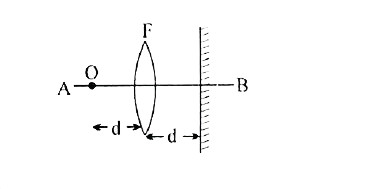a) A small object is placed 150 mm away from a diverging lens of focal length 100 mm.
i) Copy the figure below and draw rays to show how an image is formed by the lens.

ii) Calculate the distance of the image from the lens by using the lens formula.
b) The diverging lens in part a) is replaced by a converging lens also of focal length 100 nm. The object remains in the same position and an image is formed by the converging lens. Compare two properties of this image with those of the image formed by the diverring lens in part a)
a) ii) v=−60mm b) v=+300mm, The image formed by converging lens is real, inverted and magnified (2 times). It is formed behind the converging lens. On the other hand, the image is formed by diverging lens is virtual, erect and diminished. It is formed in front of the diverging lens.
Topper's Solved these Questions
- REFRACTION OF LIGHTBOOK - LAKHMIR SINGH & MANJIT KAURCHAPTER - REFRACTION OF LIGHTEXERCISE - LONG ANSWER TYPE QUESTIONS
3 Videos
- REFRACTION OF LIGHTBOOK - LAKHMIR SINGH & MANJIT KAURCHAPTER - REFRACTION OF LIGHTEXERCISE - SHORT ANSWER TYPE QUESTIONS
1 Videos
- REFRACTION OF LIGHTBOOK - LAKHMIR SINGH & MANJIT KAURCHAPTER - REFRACTION OF LIGHTEXERCISE - VERY SHORT ANSWER TYPE QUESTIONS
1 Videos
- REFLECTION OF LIGHT BOOK - LAKHMIR SINGH & MANJIT KAURCHAPTER - REFLECTION OF LIGHT EXERCISE - Very Short Answer Type Questions
1 Videos
- SOURCES OF ENERGY BOOK - LAKHMIR SINGH & MANJIT KAURCHAPTER - SOURCES OF ENERGY EXERCISE - NCERT
8 Videos
Similar Questions
Knowledge Check
A converging lens has a focal length of 0.12 m. To get an image of unit magnification the object should be placed at what distance from the converging lens ?
A0.24 mB0.12 mC0.06 mD0.4 mThe size of the image of an object, which is at infinity, as formed by a convex lens of focal length 30 cm is 2 cm. If a concave lens of focal length 20 cm is placed between the convex lens and the image at a distance of 26 cm from the convex lens, calculate the new size of the image.
A1.25cmB2.5cmC1.05cmD2cmThe size of the image of an object, which is at infinity, as formed by a convex lens of focal length 30 cm is 2 cm. If a concave lens of focal length 20 cm is placed between the convex lens and the image at a distance of 26 cm from the convex lens, calculate the new size of the image
Ad2BdC2dD3d
An object is placed at a distance of 100 cm from a converging lens of focal length 40 cm.
i) What is the nature of image?
ii) What is the position of image?
View SolutionAn extended object is placed at a distance of 5.0 cm from a convex lens of focal length 8.0 cm. (a) Draw the ray diagram (to the scale) to locate the image and from this, measure the distance of the image from the lens, (b) Find the position of the image from the lens formula and see how close the drawing is to the correct result.
View Solutiona) An object is placed 10 cm from a lens of focal length 5 cm. Draw the ray diagrams to show the formation of image if the lens is (i) converging, and ii) diverging.
b) State one practical use each of convex mirror, concave mirror, convex lens and concave lens.
View SolutionAn object is placed at the focus of concave lens having focal length /. What is the magnification and distance of the image from the optical centre of the lens ?
View SolutionIn the figure shown ‘O’ is point object. AB is principal axis of the converging lens of focal length F. Find the distance of the final image from the lens.

View Solution
